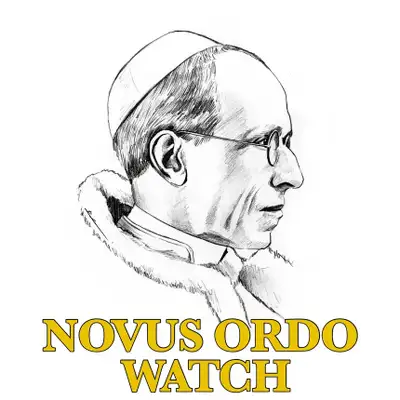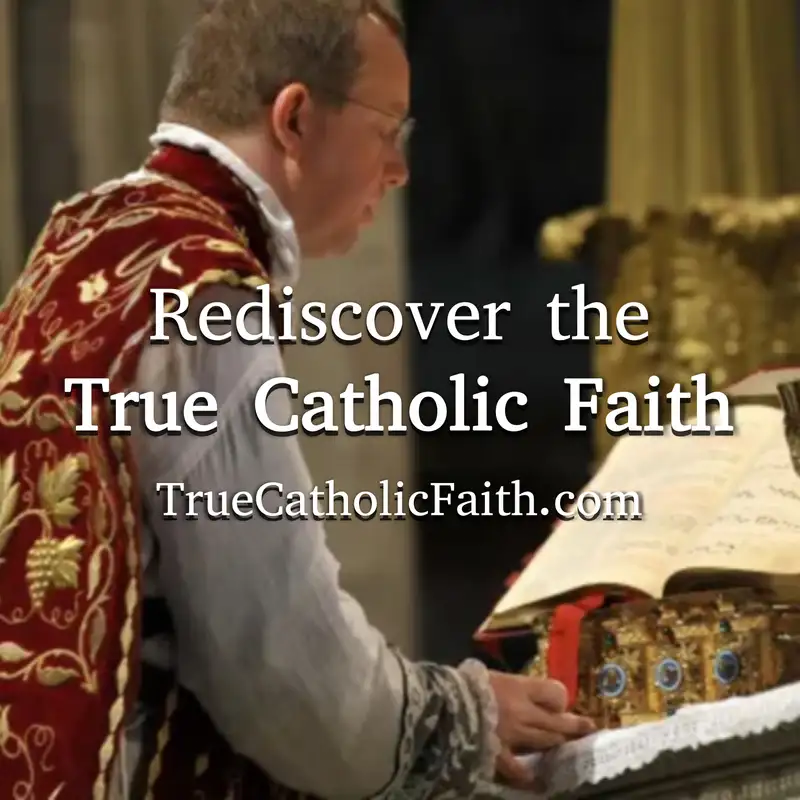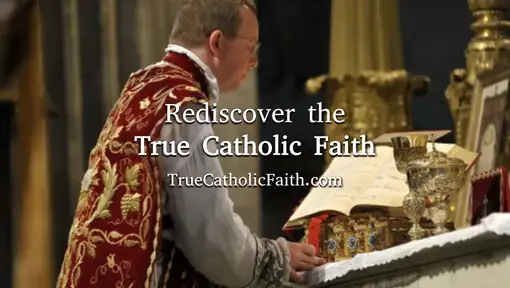The Great Apostasy - Novus Ordo Watch 08-09-25
Download MP3Summary
Tradcast Express explores the concept of the Great Apostasy—a prophesied, massive falling away from the Catholic faith that is expected to occur before the second coming of Jesus Christ. The speaker argues that the current era, shaped by the reforms of Vatican II and the rise of the “Vatican II religion,” is indeed the time of this apostasy. This falling away is not a baseless conspiracy but a doctrine rooted in divine revelation, scripture, and Catholic teaching, including both the traditional Roman Catechism and the post-Vatican II Catechism promulgated by John Paul II and updated by "Pope" Francis.
Key scriptural references include Christ’s discourse in Matthew 24 about a great deception preceding His return and St. Paul’s teaching in 2 Thessalonians 2 about a restraining force holding back the mystery of iniquity. The restrainer is analyzed, with historical interpretations ranging from St. Michael the Archangel to the Roman Empire, but the speaker highlights Cardinal Henry Edward Manning’s view that the papacy itself acts as this restraining force. According to this perspective, only when the papal seat is vacant or occupied by false popes can a widespread apostasy and deception occur.
The speaker stresses the indefectibility of the papacy, citing magisterial documents and papal encyclicals, which affirm that the Church, founded on Peter as the rock, cannot fail as long as the true papal authority persists. The current crisis is seen as a double crisis: a vacancy or eclipse of legitimate papal authority combined with the rise of false popes and heterodox teachings, leading to massive confusion and apostasy among Catholics.
The talk acknowledges the tension within the Church since Vatican II, between those who believe in the continuity of the Church’s magisterium and those who hold to sedevacantism—the belief that the papal seat is currently vacant due to heresy or illegitimacy of recent popes. The speaker critiques the modern Church’s embrace of ecumenism, interreligious dialogue, and synodality as departures from traditional teaching and points to censorship and suppression of traditional doctrine as evidence of this rupture.
Ultimately, the speaker concludes that Catholics must hold fast to the true faith revealed by God and avoid contradictions. Faith requires trust in divine authority and dogma, not proof or explanation of every mystery. The Great Apostasy is a real and pressing reality, and vigilance is necessary to avoid falling into error and losing the faith.
Highlights
- The Great Apostasy is a prophesied, massive falling away from the Catholic faith before Christ’s second coming.
- Both traditional and post-Vatican II Catechisms acknowledge the reality of a great apostasy and deception.
- Scriptural references, especially Matthew 24 and 2 Thessalonians 2, describe a great deception and a restrainer holding back evil until a set time.
- The restraining force is likely the papacy; apostasy becomes possible only when the papal seat is vacant or compromised.
- The papacy is indefectible—protected from error and collapse as long as the true pope reigns.
- Vatican II and modern Church reforms are seen as a rupture from traditional Catholic teaching, contributing to the apostasy.
- Catholics must hold firm to revealed dogma and avoid contradictions to preserve the faith against deception.
Key Insights
- Theological Foundation of the Great Apostasy: The Great Apostasy is not a fringe theory but a well-established element of Catholic eschatology, found in Scripture, traditional teaching (Council of Trent Catechism), and the modern Catechism. This underscores its importance in Catholic doctrine and the urgency of recognizing it in current times. The speaker’s reliance on both traditional and conciliar sources highlights its continuity as a teaching despite ecclesiastical changes.
- Scriptural Basis Emphasizes Deception and Apostasy: Christ’s warnings in Matthew 24 about false prophets and great deception, coupled with St. Paul’s teaching about a restraining force in 2 Thessalonians 2, give a clear biblical framework for understanding the apostasy. The “restrainer” concept is crucial because it suggests that apostasy does not happen arbitrarily but when divine permission is granted, linking ecclesial authority to eschatological events.
- The Papacy as the Restrainer: The identification of the papacy as the restraining force provides a theological explanation for how a universal apostasy could be held at bay for centuries. Historical and magisterial support for this idea, particularly from Cardinal Manning, grounds it in Church tradition. The papacy’s role is not only administrative but eschatological, safeguarding the Church’s faith until the time appointed by God.
- Indefectibility of the Papacy and Church: The Church, founded on St. Peter, is protected from ultimate collapse. Papal encyclicals cited (Pius VII, Pius IX, Pius XI) stress that the Church’s survival depends on the papal office’s authority. This doctrine supports the idea that the Church cannot fall completely as long as the true pope reigns, reinforcing the gravity if the papal seat becomes vacant or corrupted.
- Vatican II as a Rupture Leading to Apostasy: The speaker argues that the reforms and teachings of Vatican II represent a fundamental break with traditional Catholic doctrine, particularly regarding ecumenism and the nature of the Church. This rupture has caused confusion and doctrinal error, which the speaker equates to the apostasy foretold in Scripture and tradition.
- Sedevacantism as the Logical Response for Some: Given the crisis, the speaker identifies two possible positions—accepting the continuity and validity of recent popes or embracing sedevacantism, the belief that the papal seat is currently vacant due to heresy. The latter is seen as difficult but necessary for those committed to upholding true Catholic doctrine. This highlights ongoing divisions within traditionalist Catholic circles.
- Faith Must Be Rooted in Divine Authority, Not Human Explanation: The speaker emphasizes that faith is a matter of trust in God’s revelation, not complete understanding or proof. Mystery is compatible with faith, but contradiction is not. This insight serves as a call for Catholics to hold firmly to orthodox doctrine amid confusion, resisting modern theological relativism and deception.
The overall message is a call to vigilance and fidelity in a time perceived as a profound spiritual crisis, with the papacy and traditional Catholic teaching as the key bulwarks against the Great Apostasy.
Links:
Links:
- Traditional Catholic teaching on the Great Apostasy: found in The Catechism of the Council of Trent (see page 84)
- Novus Ordo teaching on the Great Apostasy: found in Catechism of the Catholic Church (see n. 675)
- Cardinal Henry Edward Manning's research on the Great Apostasy, the Pope, and the Antichrist presented in "The Persecution and ‘Death’ of the Church: The Testimony of Scripture and Tradition", Novus Ordo Watch (Jan. 18, 2024)
- Collection of authoritative quotes of magisterial documents: The Catholic Teaching on the Papacy
- Pope Pius VII, Encyclical Diu Satis (1800)
- Pope Pius IX, Encyclical Nostis et Nobiscum (1849)
- Pope Pius IX, Encyclical Inter Multiplices (1853)
- Pope Pius VI, Apostolic Constitution Super Soliditate (1786)
- Pope Pius IX, Apostolic Letter Iam Vos Omnes (1868)
- Pope Leo XIII, Encyclical Satis Cognitum (1896)
- Pope Pius XI, Encyclical Mortalium Animos (1928)
- "Cardinal of Barcelona Bans Lecture on Christ the King", Gloria.TV (Jan. 14, 2025)
- Pope Pius XI, Encyclical Quas Primas (1925)
Creators and Guests

Guest
Novus Ordo Watch
Novus Ordo Watch is a lay-led internet apostolate whose primary goal is to educate the public about the true Roman Catholic religion and the institution we refer to as the “Novus Ordo Sect” (or “Vatican II Sect”), a Neo-Modernist sect which falsely claims to be the Roman Catholic Church and has illegitimately occupied the official Catholic structures in the Vatican and throughout the world since its de facto founding by Cardinal Angelo Roncalli after the death of Pope Pius XII in 1958. Although the actual date of inception of the Vatican II Sect is Oct. 28, 1958 — the day Cardinal Roncalli was invalidly elected “Pope”, taking the name John XXIII (1958-63) — the manifestation of this new religion was a bit more gradual. With moral certainty one can say that the new religion was objectively manifest no later than December 8, 1965, the day “Pope” Paul VI (1963-78) officially ratified, promulgated, and closed the so-called Second Vatican Council. Paul VI — Bishop Giovanni Battista Montini — had been John XXIII’s crown prince from the beginning, and while John functioned mainly as the preparer and herald of the new religion, Paul VI was its main architect and chief promoter. Most of the content on the Novus Ordo Watch web site focuses on demonstrating how the teachings and practices of the Vatican II Sect differ essentially — that is, not merely in accidentals but in substance — from those of the Roman Catholic Church and contradict them. Since the Catholic Church is divinely protected from failing and enjoys “perfect and perpetual immunity … from error and heresy” (Pius XI, Encyclical Quas Primas, n. 22), it is necessary to hold that the apparent authorities that introduced these substantial changes in Catholic teaching were not legitimate and did not in fact hold their putative offices validly. Hence we believe that the last legitimate and valid Pope of the Roman Catholic Church was Pius XII, who reigned from March 2, 1939 until October 9, 1958. This theological position we subscribe to is typically referred to as “Sedevacantism”, from the Latin term sede vacante, “the Chair [of Peter] being vacant”. We believe that the men who are considered by the world to be the successors of Pius XII — that is, John XXIII, Paul VI, John Paul I, John Paul II, Benedict XVI, and Francis — are usurpers, false popes (anti-popes) who have occupied the Chair of St. Peter not only illicitly (without permission) but also invalidly (without legal or moral force). Indeed, we believe that the Throne of St. Peter has been vacant (empty) since the passing of Pius XII, although we acknowledge as a possibility that a true Pope was elected at some point after Pius XII and then impeded from exercising his papacy. So, why is this web site called “Novus Ordo Watch”? On April 3, 1969, the first day of the Jewish Passover and Holy Thursday in the Roman calendar, “Pope” Paul VI introduced what he claimed was simply a “reform” of the Holy Catholic Mass based on “more ancient liturgical sources” (see Paul VI, Missale Romanum). He called it the “new order of the Mass,” or, in the official Latin document, the “novus Ordo Missae“. This “new order of the Mass”, a term more pregnant with meaning than he then realized perhaps, gradually came to be known as the “Novus Ordo Mass”, or simply the “New Mass”. Since then, true Catholics who have kept the Faith handed down to us unadulterated from Pope St. Peter until Pope Pius XII, have come to label the entire new religion this “Mass” expresses as “Novus Ordo”, and hence we refer to it as the “Novus Ordo religion” and its worldwide establishment headquartered in the Vatican as the “Novus Ordo Church”. As the purpose of this web site is to continually monitor this strange new church, we decided to call it “Novus Ordo Watch.”

